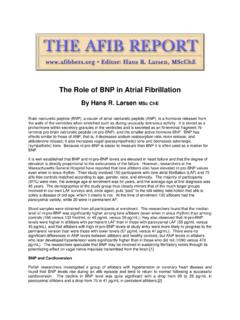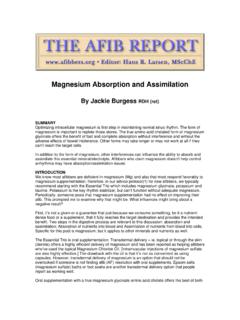Transcription of Electrical Cardioversion - Atrial fibrillation
1 Electrical Cardioversion By Hans R. Larsen MSc ChE Background Cardioversion is used to convert a patient experiencing highly symptomatic or persistent Atrial fibrillation (AF) to normal sinus rhythm (NSR). Conversion can sometimes be achieved by the infusion of drugs like ibutilide (Covert), dofetilide (Tikosyn) or flecainide (Tambocor) in a hospital setting (chemical conversion). Chemical conversion is most effective if started within a couple of hours of the onset of the episode and becomes less effective as time goes by. In cases where an episode has lasted longer than 7 days drug-induced conversion is not effective and Electrical conversion ( Cardioversion ) must be used to regain NSR, either alone or in combination with antiarrhythmic drugs. Cardioversion is also sometimes used instead of drugs in an attempt to convert an AF patient who has just arrived in hospital if the patient suffers severely (fainting, dizziness, breathlessness, etc).
2 Electrical Cardioversion (also known as direct-current or DC Cardioversion ) is a procedure whereby a synchronized Electrical current (shock) is delivered through the chest wall to the heart through special electrodes or paddles that are applied to the skin of the chest and back. The purpose of the Cardioversion is to interrupt the abnormal Electrical circuit(s) in the heart and to restore a normal heartbeat. The delivered shock causes all the heart cells to contract simultaneously, thereby interrupting and terminating the flutter or AF without damaging the heart. The heart s Electrical system then restores a normal heartbeat controlled by the sinus node. Research has shown that delivering the initial shock with an energy level of 200 to 360 joule is more effective than starting out at a lower level.[1] The procedure is preferably performed in the fasting state with the patient receiving short-acting anesthetic drugs or drugs that produce conscious sedation.
3 Recovery is usually quick and overnight hospitalization is seldom required. Skin burns and ischemic stroke are the most common adverse effects accompanying the procedure. Patients with a low blood serum level of potassium or a toxic level of digoxin may experience life-threatening ventricular fibrillations when undergoing Cardioversion . Thus potassium levels should always be checked prior to Cardioversion and corrected if necessary. Prevention of Cardioversion -Associated Stroke The conversion of Atrial fibrillation to NSR results in a transient mechanical dysfunction of the left atrium and the left Atrial appendage (LAA) known as stunning . During stunning, thrombi (blood clots) can form in the left atrium and the LAA. These thrombi are expelled once normal pumping action is restored and may result in an ischemic stroke or transient ischemic attack (TIA) usually within the first 10 days following Cardioversion .
4 Depending on the time elapsed between the onset of an AF episode and the Cardioversion procedure it is also possible that clots may form in the LAA and left atrium. These clots may be dislodged and cause a stroke or TIA once the stronger pumping action inherent in NSR is resumed. It is thus standard practice to postpone Cardioversion for 3 to 4 weeks if an episode has lasted longer than 48 hours. During the waiting period, warfarin (Coumadin) adjusted to an INR between and is administered in order to prevent procedure-associated TIA or stroke. Warfarin is also prescribed for 4 weeks following the procedure. In some cases it may be possible to safely perform Electrical Cardioversion without prior anticoagulation even if episode duration exceeds 48 hours. A team of American, Australian and German researchers has found that Electrical Cardioversion can be performed safely without the 3-week pretreatment with warfarin if a transesophageal echocardiogram (TEE) taken immediately prior to Cardioversion shows no signs of thrombi in the left atrium.
5 The clinical trial involved 525 patients assigned to TEE prior to Cardioversion and 509 patients assigned to the conventional 3-week course of warfarin. The average age of the patients was 65 years and most of them had one or more comorbid conditions such as hypertension, or congestive heart failure. All patients had been in AF for at least 48 hours prior to enrolment and 82% were taking one or more antiarrhythmic drugs. The patients in the TEE group underwent TEE, anticoagulation with unfractionated heparin, and Cardioversion within 3 days of enrolment, while patients in the conventional group underwent Electrical Cardioversion between 20 and 40 days after enrolment. The immediate conversion rate (to normal sinus rhythm) was 82% in the TEE group and in the conventional group. The TEE indicated the presence of thrombi in 62 patients and Cardioversion was postponed for this group.
6 After 6 months of patients in the TEE group who had undergone Cardioversion were still in sinus rhythm as compared to in the conventional group. The incidence of ischemic (embolic) stroke and TIA (transient ischemic attack) was in the TEE-guided group and in the conventional group; however, this difference was not statistically significant. The rate of serious bleeding events was significantly higher in the conventional group ( ) than in the TEE-guided group ( ). Death from cardiovascular causes over the 6-month follow-up period was similar in the two groups at 2% and most were classified as sudden cardiac death not involving stroke or bleeding. The researchers conclude that TEE-guided Electrical Cardioversion is a clinically effective alternative to the conventional anticoagulation strategy followed by Cardioversion . They point out that the TEE-guided approach may be particularly useful in highly symptomatic, new onset AF and for patients at high risk for bleeding and stroke.
7 [2] Success Rate for Cardioversion Although the immediate success rate of Electrical Cardioversion is quite high at 80 to 90%, the relapse rate is substantial. Researchers at the Mayo Clinic recently reported the results of a study aimed at determining the long-term effectiveness of Cardioversion . The study included 351 patients with Atrial fibrillation (179 with a first episode) and 126 patients with Atrial flutter (78 with a first episode). The patients were all over the age of 60 years and most had hypertension (68%), while 49% had moderate to severe Atrial enlargement. Most were on one or more medications including 29% on digoxin, 92% on warfarin, and 53% on ACE inhibitors or angiotensin-converting enzyme inhibitors. The study participants underwent Electrical Cardioversion and were then followed-up for a year. At the one-year follow-up 63% of the patients who had been cardioverted after a first Atrial flutter episode remained in NSR.
8 However, only 33% of flutter patients with recurrent episodes remained in NSR. The results for afibbers were even worse. Only 30% of patients in the new-onset afib group and 35% in the recurrent group were still in NSR after a year. It is interesting that not all Atrial flutter patients relapsed into Atrial flutter. In patients with recurrent Atrial flutter, 39% relapsed into Atrial fibrillation . AF patients, on the other hand, almost always (92-95% of cases) relapsed back into Atrial fibrillation rather than into Atrial flutter. Electrical Cardioversion is clearly not very effective for the general afib population and there is no evidence that it is more effective for lone afibbers. However, there is some evidence that effectiveness increases if used together with antiarrhythmic drugs.[3] A group of cardiologists at the James Cook University Hospital report that pre- and post-treatment with amiodarone greatly improves the chances of staying in NSR after Cardioversion .
9 Their clinical trial included 91 patients with persistent or permanent afib scheduled for Cardioversion after 6 weeks of warfarin therapy. During the 6-week waiting period 20 patients were randomized to receive amiodarone (200 mg 3 times daily for the first week, 200 mg 2 times daily for the second week, and then 200 mg daily for the remainder of the trial period); 28 patients received sotalol (160 mg twice a day, or 80 mg twice a day if intolerant of the higher dose) and the remaining 29 patients received no antiarrhythmic drug. All patients were given beta-blockers (usually atenolol) or digoxin as required for rate control and all remained on the drug regimen in effect pre- Cardioversion for the entire 6-month observation period. During the 6-week waiting period 7 patients in the amiodarone group and 7 in the sotalol group converted spontaneously to NSR and were not given Cardioversion .
10 None of the patients not receiving antiarrhythmics converted on their own. The immediate success rate of Cardioversion (patients in NSR at time of discharge from the hospital) was 92% for those in the sotalol group, 81% in the amiodarone group, and 74% in the no-antiarrhythmic group. Unfortunately, the effects of the Cardioversion did not last. Six weeks after DCC only 53% of those in the sotalol group, 67% in the amiodarone group, and 42% in the no-antiarrhythmic group were still in NSR. Corresponding numbers at the end of the trial were 39%, 63%, and 16%. The researchers conclude that amiodarone (200 mg a day) is more effective than sotalol (160 mg twice a day) in maintaining NSR after Cardioversion . Adverse effects were observed in 4% of the patients assigned to amiodarone and in 11% assigned to sotalol. It is very clear from this clinical trial that Electrical Cardioversion on its own (without concomitant use of antiarrhythmics) is ineffective in maintaining NSR in persistent and permanent afibbers.



